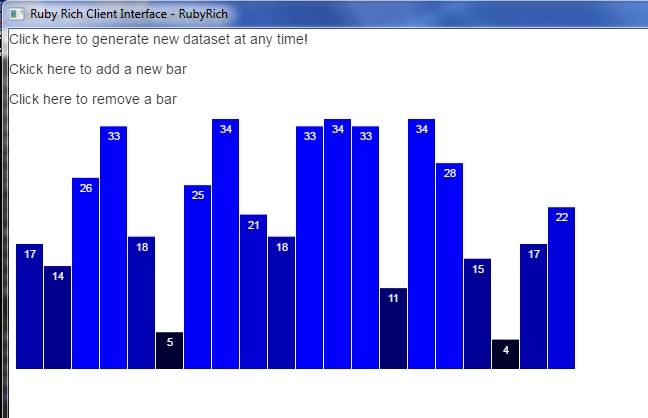Home
Rodrigo Botafogo edited this page Jan 5, 2017
·
6 revisions
Welcome to the mdarray-sol wiki!
require 'mdarray-sol'
require_relative '../util/ordinal_scale'
require_relative '../util/linear_scale'
class BarChart
attr_reader :dataset
attr_reader :width
attr_reader :height
attr_reader :svg
attr_reader :padding
attr_reader :x_scale
#--------------------------------------------------------------------------------------
# Initialize the bar chart and create the main svg for the plot with the given
# width and height and padding
#
# @param dataset [Array] an array of points in the form of [x, y]
# @param width [Number] the width of the plot
# @param height [Number] the height of the plot
# @param padding [Number] a padding for the plot. Uses the same padding for x and y
# dimension. Could be improved by adding different paddings for x and y
#--------------------------------------------------------------------------------------
def initialize(dataset, width:, height:, padding:)
@dataset = dataset
@width = width
@height = height
@padding = padding
@svg = $d3.select("body")
.append("svg")
.attr("width", @width)
.attr("height", @height)
end
#--------------------------------------------------------------------------------------
# @param x_scale [OrdinalScale] the scale for the data, this is a Scale object that
# encapsulates the scale function from d3. scale defauts to the bar chart scale.
# Usually this will always be the case, but we need to set it since scale is used
# inside a block
#--------------------------------------------------------------------------------------
def add_data
x_scale, y_scale, height = @x_scale, @y_scale, @height
@svg.selectAll("rect")
.data(@dataset) { |d| d[:key] }
.enter(nil)
.append("rect")
.on("mouseover") { $d3.select(@this).attr("fill", "orange") }
.on("mouseout") { |d| $d3.select(@this)
.transition(nil)
.duration(500)
.attr("fill", "rgb(0, 0, #{(d[:value] * 10).to_i})" )}
.attr("x") { |d, i| x_scale[i]}
.attr("y") { |d, i| height - y_scale[d[:value]] }
.attr("width", x_scale.scale.rangeBand(nil))
.attr("height") { |d, i| y_scale[d[:value]] }
.attr("fill") { |d, i| "rgb(0, 0, #{(d[:value] * 10).to_i})" }
end
#--------------------------------------------------------------------------------------
# Defines the style of the labels. Although this does not make much sense, since this
# is fixed, one could consider building the style dynamically.
#--------------------------------------------------------------------------------------
def style
{"font-family" => "sans-serif",
"font-size" => "11px",
"fill" => "white",
"text-anchor" => "middle"}
end
#--------------------------------------------------------------------------------------
#
#--------------------------------------------------------------------------------------
def add_labels
x_scale, y_scale, height = @x_scale, @y_scale, @height
@svg.selectAll("text")
.data(@dataset) { |d| d[:key] }
.enter(nil)
.append("text")
.text { |d, i| d[:value] }
.attr({"x"=> ->(d, i, z) {x_scale[i] + x_scale.scale.rangeBand(nil) / 2},
"y"=> ->(d, i, z) {height - y_scale[d[:value]] + 14 }})
.attr(style)
end
#--------------------------------------------------------------------------------------
# Plots the bar chart
#--------------------------------------------------------------------------------------
def plot
y_min, y_max = @dataset.minmax_by { |d| d[:value] }
# Creates a new x and y scale for the plot
@x_scale = OrdinalScale.new([*0..@dataset.length], @width)
@y_scale = LinearScale.new([0, y_max[:value]], [0, @height])
add_data
add_labels
end
...
#--------------------------------------------------------------------------------------
# updates the bars with new data
#--------------------------------------------------------------------------------------
def update_bars
# correct the x scale to the new dataset
@x_scale.domain([*0..@dataset.length])
# correct the y scale to the new dataset
y_min, y_max = @dataset.minmax_by { |d| d[:value] }
@y_scale.update([0, y_max[:value]], [0, @height])
# Set local variable to their equivalent instance variable so that they are
# available inside blocks. I don´t know if there is a better way of doing
# this. Tried googling for a better solution but without success!
x_scale, y_scale, height = @x_scale, @y_scale, @height
svg.selectAll("rect")
.data(@dataset) { |d| d[:key] }
.transition(nil)
.delay { |d, i| i * 100 }
.duration(100)
.attr("x"=> ->(d, i, z) { x_scale[i] })
.attr("y"=> ->(d, i, z) {height - y_scale[d[:value]] })
.attr("width", x_scale.scale.rangeBand(nil))
.attr("height"=> ->(d, i, z) {y_scale[d[:value]]})
.attr("fill") { |d, i| "rgb(0, 0, #{(d[:value] * 10).to_i})" }
end
#--------------------------------------------------------------------------------------
# updates the labels
#--------------------------------------------------------------------------------------
def update_labels
x_scale, y_scale, height = @x_scale, @y_scale, @height
svg.selectAll("text")
.data(@dataset) { |d| d[:key] }
.transition(nil)
.delay { |d, i| i * 100 }
.duration(500)
.text { |d, i| d[:value] }
.attr({"x"=> ->(d, i, z) {x_scale[i] + x_scale.scale.rangeBand(nil) / 2},
"y"=> ->(d, i, z) {height - y_scale[d[:value]] + 14 }})
.attr(style)
end
#--------------------------------------------------------------------------------------
# This method is called when the dataset is updated. This will trigger the update of
# points, labels and axes
#
# @param dataset [Array] a new dataset with the same number of elements as the previous
# dataset
#--------------------------------------------------------------------------------------
def update(dataset)
@dataset = dataset
update_bars
update_labels
end
#--------------------------------------------------------------------------------------
# Removes a bar from the plot
#--------------------------------------------------------------------------------------
def remove_bar
@dataset.shift
@svg.selectAll("rect")
.data(@dataset) { |d| d[:key] }
.exit(nil)
.transition(nil)
.duration(500)
.remove(nil)
@svg.selectAll("text")
.data(@dataset) { |d| d[:key] }
.exit(nil)
.remove(nil)
update_bars
update_labels
end
#--------------------------------------------------------------------------------------
# Adds a single bar to the chart. The @dataset was already updated
#--------------------------------------------------------------------------------------
def add_bar
# add the new bar. No need to add attributes as the whole plot will be updated next
@svg.selectAll("rect")
.data(@dataset) { |d| d[:key] }
.enter(nil)
.append("rect")
.on("mouseover") { $d3.select(@this).attr("fill", "orange") }
.on("mouseout") { |d| $d3.select(@this)
.transition(nil)
.duration(500)
.attr("fill", "rgb(0, 0, #{(d[:value] * 10).to_i})" )}
update_bars
# add the new label. Need only to add the text value as all attributes will be set
# by update_labels
@svg.selectAll("text")
.data(@dataset) { |d| d[:key] }
.enter(nil)
.append("text")
.text { |d, i| d[:value] }
update_labels
end







